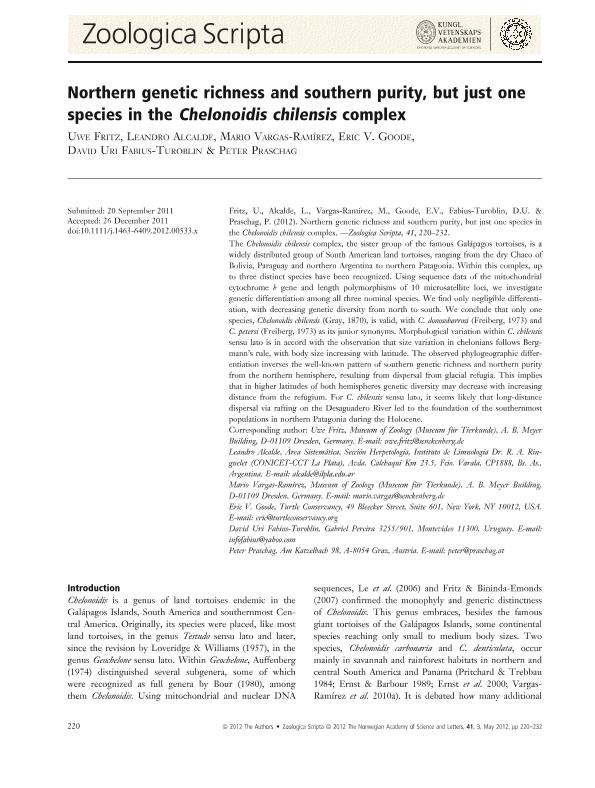Artículo
Northern genetic richness and southern purity, but just one species in the Chelonoidis chilensis complex
Fritz, Uwe; Alcalde, Leandro ; Vargas Ramírez, Mario; Goode, Eric V.; Fabious Turoblin, David Uri; Praschag, Peter
; Vargas Ramírez, Mario; Goode, Eric V.; Fabious Turoblin, David Uri; Praschag, Peter
 ; Vargas Ramírez, Mario; Goode, Eric V.; Fabious Turoblin, David Uri; Praschag, Peter
; Vargas Ramírez, Mario; Goode, Eric V.; Fabious Turoblin, David Uri; Praschag, Peter
Fecha de publicación:
02/2012
Editorial:
Wiley
Revista:
Zoologica Scripta
ISSN:
0300-3256
e-ISSN:
1463-6409
Idioma:
Inglés
Tipo de recurso:
Artículo publicado
Clasificación temática:
Resumen
The Chelonoidis chilensis complex, the sister group of the famous Galápagos tortoises, is a widely distributed group of South American land tortoises, ranging from the dry Chaco of Bolivia, Paraguay and northern Argentina to northern Patagonia. Within this complex, up to three distinct species have been recognized. Using sequence data of the mitochondrial cytochrome b gene and length polymorphisms of 10 microsatellite loci, we investigate genetic differentiation among all three nominal species. We find only negligible differentiation, with decreasing genetic diversity from north to south. We conclude that only one species, Chelonoidis chilensis (Gray, 1870), is valid, with C. donosobarrosi (Freiberg, 1973) and C. petersi (Freiberg, 1973) as its junior synonyms. Morphological variation within C. chilensis sensu lato is in accord with the observation that size variation in chelonians follows Bergmann’s rule, with body size increasing with latitude. The observed phylogeographic differentiation inverses the well-known pattern of southern genetic richness and northern purity from the northern hemisphere, resulting from dispersal from glacial refugia. This implies that in higher latitudes of both hemispheres genetic diversity may decrease with increasing distance from the refugium. For C. chilensis sensu lato, it seems likely that long-distance dispersal via rafting on the Desaguadero River led to the foundation of the southernmost populations in northern Patagonia during the Holocene.
Palabras clave:
Chelonoidis Chilensis
,
Species Complex
Archivos asociados
Licencia
Identificadores
Colecciones
Articulos(ILPLA)
Articulos de INST.DE LIMNOLOGIA "DR. RAUL A. RINGUELET"
Articulos de INST.DE LIMNOLOGIA "DR. RAUL A. RINGUELET"
Citación
Fritz, Uwe; Alcalde, Leandro; Vargas Ramírez, Mario; Goode, Eric V.; Fabious Turoblin, David Uri; et al.; Northern genetic richness and southern purity, but just one species in the Chelonoidis chilensis complex; Wiley; Zoologica Scripta; 41; 3; 2-2012; 220-232
Compartir
Altmétricas



